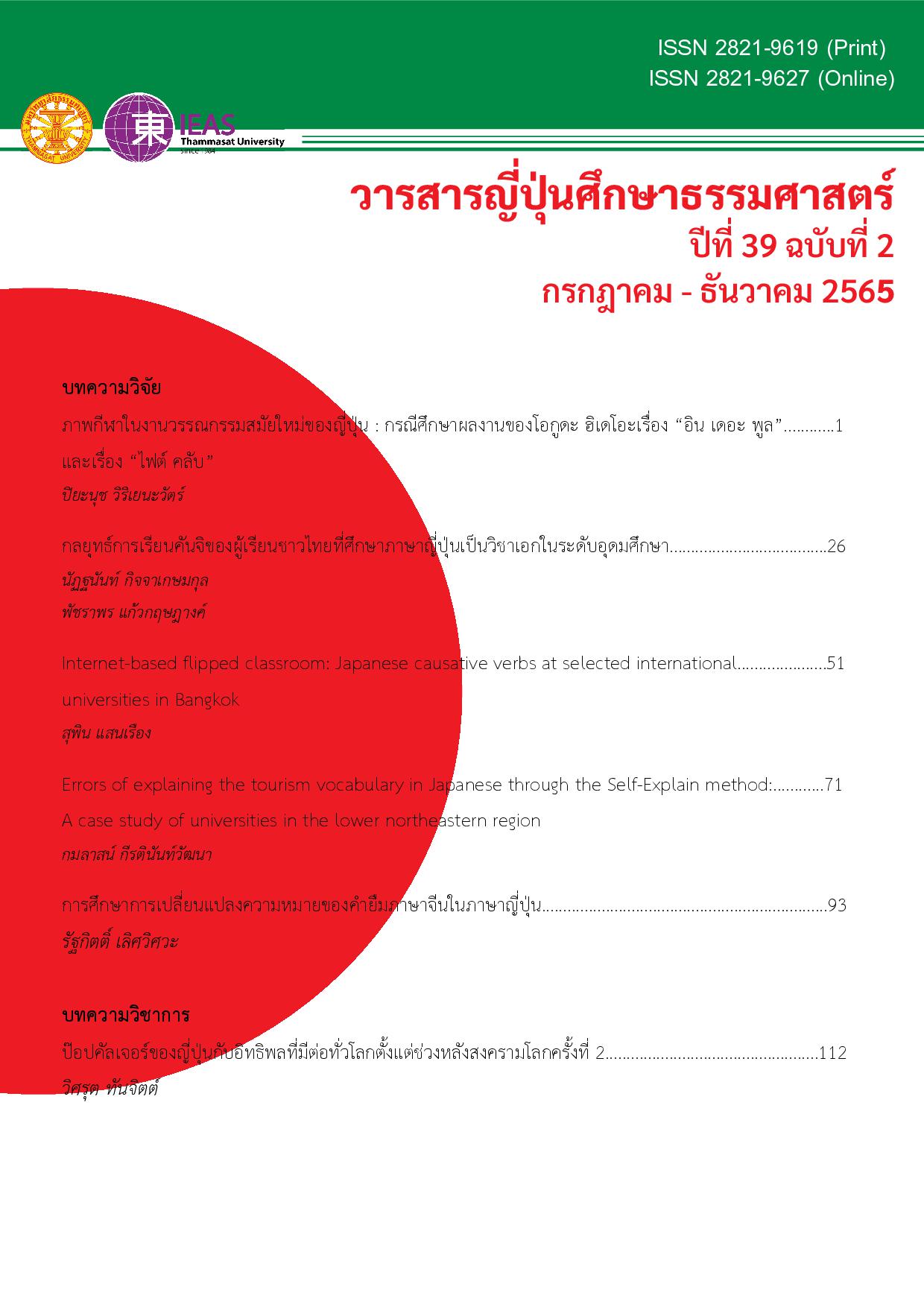Japan’s Pop Culture and its Global Influence since the Aftermath of World War II
Keywords:
pop culture, economic power, cultural power, Cool JapanAbstract
This paper focused on the influence of Japan’s pop culture from Japan and other foreign countries in each period starting from after the World War II. The study showed that Japan’s pop culture had its dynamic. To illustrate, it changed over time, also over changes in both domestic and international levels. Moreover, the increasing global influence regarding Japan’s pop culture in the 1990s brought about the policy that included pop culture as a part of Japanese culture for the first time ever, named ‘Cool Japan’. This policy had a goal of making the new Japan’s image as the lead exporter of cultural goods, combining with building soft power for the purpose of more political and economic interests in the future.
Downloads
References
ณัฐณิชา วัฒนพานิช. (2552). การเปิดรับวัฒนธรรมป็อปญี่ปุ่นของวัยรุ่นไทยจากสื่อมวลชนและแรงจูงใจในการเรียนภาษาญี่ปุ่น [วิทยานิพนธ์ปริญญานิเทศศาสตร์มหาบัณฑิต, จุฬาลงกรณ์มหาวิทยาลัย]. Chulalongkorn University Intellectual Repository (CUIR). http://cuir.car.chula.ac.th/handle/123456789/16809
Alt, M. (2021). Plugging In and Dropping Out, In M. Alt (Ed.), Pure Invention: How Japan's Pop Culture Conquered the World (pp. 131 - 162). Crown.
Bain, M. (2020, May 21). How Japan's Global Image Morphed from Military Empire to Eccentric Pop-Culture Superpower. https://qz.com/1806376/japans-image-has-changed-from-fierce-to-lovable-over-the-decades/.
Bourdaghs, M. K. (2011). New Music and The Negation of The Negation. In M. K. Bourdaghs (Ed.), Sayonara Amerika, sayonara Nippon: a geopolitical prehistory of J-pop. (pp.159 - 190). Columbia University Press.
Chun, J. M. (2018). The ‘Pop Pacific’ - Japanese-American Sojourners and the Development of Japanese Popular Music. In T. Slade & A. Freedman (Eds.), Introducing Japanese Popular Culture (pp. 148 - 156). Routledge.
Hosogawa S. (1999). Soy Sauce Music: Haruomi Hosono and Japanese Self-Orientalism. In P. Hayward (Ed.), Widening the Horizon: Exoticism in Post-War Popular Music. (pp. 114 - 144). John Libbey Publishing.
Higgins, B. (2020, January 11). Hollywood Flashback: 'Rashomon' Won an Oscar and Broke Records in 1952. https://www.hollywoodreporter.com/movies/movie-news/hollywood-flashback-rashomon-won-an-oscar-broke-records-1952-1265764/.
IGN Staff. (2012, June 22). History of the PlayStation. https://www.ign.com/articles/1998/08/28/history-of-the-playstation.
Intellectual Property Headquarters. (n.d.). Cool Japan Initiative. https://www.cao.go.jp/cool_japan/english/pdf/cooljapan_initiative.pdf
Iwabuchi, K. (2002). Taking “Japanization” seriously: Cultural globalization reconsidered. In K.Iwabuchi (Ed.), Recentering Globalization: Popular Culture and Japanese Transnationalism. (pp. 23 - 50). Duke University Press.
Iwabuchi, K. (2015). Pop-culture diplomacy in Japan: soft power, nation branding and the question of ‘international cultural exchange. International Journal of Cultural Policy, 21(4), 419 - 432. https://doi.org/10.1080/10286632.2015.1042469.
Japan External Trade Organization. (2021). Tourism Report. https://www.jetro.go.jp/ext_images/en/invest/img/attractive_sectors/tourism/tourism_EN_202103.pdf
Kasavin, G. (1997, September 29). Final Fantasy VII Review. https://www.gamespot.com/reviews/final-fantasy-vii-review/1900-2547583/.
Kohler, C. (2016). Pokémon : Shikaku Sedai No Sekai Shôhin. In C. Kohler (Ed.), Power-Up: How Japanese Video Games Gave the World an Extra Life. (pp. 292 - 304). Dover Publications.
Kuwabara, M. (2019, March 6). Heisei Blues: The Post-Bubble Struggles of Japan’s Financial Sector. https://www.nippon.com/en/in-depth/d00470/heisei-blues-the-post-bubble-struggles-of-japan’s-financial-sector.html
Leheny, D. (2006). A Narrow Place to Cross Swords: "Soft Power" and the Politics of Japanese Popular Culture in East Asia. In P. J. Katzenstein & T. Shiraishi. (Eds.), Beyond Japan: The Dynamics of East Asian Regionalism. (pp.211-236). Cornell Universitv Press.
Matsui, T. (2014). Nation Branding Through Stigmatized Popular Culture: The ‘Cool Japan’ Craze Among Central Ministries In Japan. Hitotsubashi Journal of Commerce and Management, 48(1), 81-97. https://hermes-ir.lib.hit-u.ac.jp/hermes/ir/re/26980/
McGray, D. (2002). Japan's Gross National Cool. Foreign Policy, 130, 44 - 54. https://doi.org/10.2307/3183487.
Miège, B. (2011). Theorizing the Cultural Industries: Persistent Specificities and Reconsiderations (C. Salles, Trans.). In J. Wesko, G. Murdoch & H. Sousa. (Eds.), The Handbook of Political Economy of Communications. (pp.83-108). Blackwell Publishing.
Ministry of Foreign Affairs of Japan. (2022). Opinion Poll on Japan. https://www.mofa.go.jp/files/100348544.pdf
Motion Picture Producers Association of Japan , Inc. (n.d.). What Is the Motion Picture Producers Association of Japan, Inc.?. http://www.eiren.org/aboutus_e/.
Ozmazgin N. K. (2012). Geopolitics and Soft Power: Japan's Cultural Policy and Cultural Diplomacy in Asia. Asia-Pacific Review, 19(1), 37 - 61. https://doi.org/10.1080/13439006.2012.678629.
Ryfle, S. (1998). Birth of a Legend. In S. Ryfle (Ed.), Japan's Favorite Mon-Star (The Unauthorized Biography of Godzilla). (pp. 19 - 60). ECW Press.
Tobin, J. (2004). Introduction. In J. Tobin (Ed.), Pikachu's Global Adventure: The Rise and Fall of Pokémon (pp. 3 - 11). Duke University Press.
Toyoshima, N. (2011). Consuming Japan: The Consumption of Japanese Cultural Products in Thailand [Doctoral dissertation, Waseda University]. Waseda University Repository. https://waseda.repo.nii.ac.jp/?action=repository_uri&item_id=25190
Downloads
Published
Issue
Section
License
Copyright (c) 2022 Thammasat Journal of Japanese Studies

This work is licensed under a Creative Commons Attribution-NonCommercial-NoDerivatives 4.0 International License.




